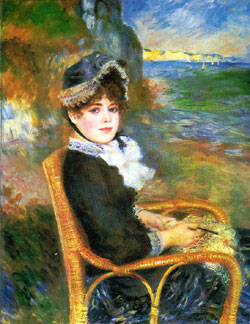In all honesty, Impressionism is far from forgetful. Impressionism is the technique of showing the world or anything in a different way. Impressionists art was not clearly defined by lines, nor were the art pieces free of brush stroke lines. In fact Impressionists went against what the Academy taught and instead focused on shedding a different kind of light on what people saw. The art during the Impressionism era was created with a lack of clear definition of detail, as well as colors that blended with each other compatibly even if they were completely different colors. Doing this sometimes the artist would highlight the foreground by making whatever was in the foreground 3-D and the background flat looking.
 |
| By the Sea by Renoir |
Monet and Renoir were two Impressionists during the time. they were "rejected for not painting bloodied corpses in ruined boulevards" (p 121). However, in today's time both Monet and Renoir are very famous for their works of art because there art was different and went against the norms of how art was in that day and age. Impressionism is far from "forgetful" in relation to artistic technique and tradition. I mean yes, Impressionism was not the typical way to create art. Yet, Impressionism created a new way to display are and create art and be able to get across a message. In a way though Impressionism was not clearly defined by detail or lines and definition, sometimes when looking deeper into a painting one will notice little clues to what a painting could be about, and that is a way Impressionism leaves an everlasting mark.
Renoir's painting (shown above) depicts a woman by the sea. However, like Impressionist paintings, the background is flattened behind the foreground. The colors as well in the background have been blended together and look almost like a backdrop behind the woman. As for the woman in the foreground, one can see that there are still no set lines within her figure or the chair leaving very little definition besides the colors that compose her. This was how Impressionist paintings were. And just like that, looking into her eyes and at how the woman and the almost backdrop looking background, one could see what the painting means, and therefore the painting could leave an impression on them.
 |
| Starry Night by Vincent Van Gogh |
With color Impressionism takes a lead in standing out and being remembered. Typical paintings displayed what the artist saw and tried to accurately recreate the piece that the artist is focusing on. However, with Impressionism he color could be skewed in a way to depict a certain mood or even a message. The art work for impressionism could be seen as more symbolic with how colors were made to make a mark on the viewer. Say the painting that you were looking at is the one above. The colors and brightness of the landscape is beautiful and gives off a happier feeling, like one is content with life. Though the larger figure in front is dark and somewhat chaos looking, it is the sky and the brightness that can pull the viewer away from the chaos and bring the viewer to feel content.
Though Impressionism was rejected by many, it still stood strong. Impressionism i a type of art that could not, can not, and will not be forgotten because it paved a way for what art could become. The art was meant to leave an impression on the viewer when looking at the painting. That is way it will not be forgotten because every person that has seen an Impressionist painting, that painting has left an impression on them never letting them forget it.





